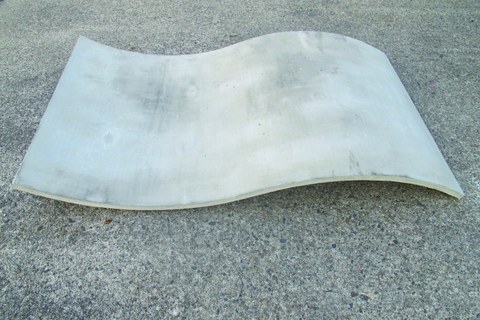Flexible mechanized technology and corresponding plant equipment for production of flat TRC components with integrated fasteners
Table of contents
Project data
|
Titel | Title |
Report in the yearbook 2012
Lightweight Elements – Easily Produced

Rectangular double wave for indoor use made of TRC
The use of textile reinforced concrete (TRC) enables the production of concrete structures which are lightweight, resistant to corrosion and which can carry heavy loads. Due to the free formability of this innovative composite material, consisting of flexible, high performance textile reinforcements and high strength concrete matrices, it can even be used for surfaces which are very thin and curved without problems.
So far TRC elements have generally been produced manually. While this is practicable for individual pieces or for production of a small number of items, it is disadvantageous for mass production. Consequently, a partially mechanized production process was developed in the framework of the project. This permits the easier and more economical manufacturing of the elements in a place which is directly on the construction side. With the help of this flexible technology and the relevant machines and tools, textile reinforced concrete elements can be reproduced on a high qualitative level. The manufactured elements are thin walled, they can be produced in different dimensions, plane or two-dimensionally curved. Furthermore, depending on the requirements the surface can be structured.
Parallel to the development of the mechanized manufacturing process, extensive research regarding the planning, construction and design of the produced textile reinforced elements was conducted at our Institute of Concrete Structures. Having created requirement profiles based on possible applications and components, the starting materials could be chosen and matched to meet the required outcome. The mechanical parameters of the composite material were determined in laboratory experiments and, subsequently, used to define the design characteristics. These parameters in combination with the developed requirements and recommendations permit the planning, construction and design of textile reinforced concrete components which have been produced partially mechanized.
Sample specimens were tested in load tests to prove the suitability of the newly developed technology. These tests proved a high load bearing capacity. Simulations of the components’ behaviour by means of the finite element method (FEM) confirmed the conducted tests. The project was successfully completed with the development of an investigation plan for the quality control regarding the components’ production.
